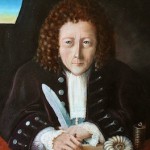Newton versus Hooke
Simulating the debate on bodies falling through a rotating Earth.
Overview
This page provides a synopsis of a historical debate between Newton and Hooke on the path of a body falling through a rotating Earth. A package of computer simulations is provided to illustrate the various conjectures made by Newton and Hooke about this motion. Each conjecture is based on a different set of implicit assumptions about the gravitational and resistive forces acting on the body as it moves through the Earth.
Synopsis of the Debate
The debate between Newton and Hooke about the fall of a body through a rotating Earth was carried out through a series of letters between the two men. On 24 November 1679 Hooke wrote to Newton, inviting Newton to take part in the scientific discussions of the Royal Society (of which Hooke had recently been appointed Secretary). The debate was
carried out in subsequent letters, as summarized below (all dates “old style”).
- 28 Nov 1679: Newton suggests dropping object from tall tower (or down deep well) to prove rotation of Earth. He suggests that the object will experience an eastward deflection because it is moving faster than the point on Earth’s surface directly below it. (See Fall To Earth simulation.) He sketches the path of a body (in the Earth’s rotating frame), showing the body fall through the Earth and eventually reach the center.
- 9 Dec 1679: Hooke agrees about the eastward deflection for an object on the Equator, but suggests that the object’s path would “resemble An Elleipse” if the “gravitation to the former Center remained as before.” (See Hooke’s Ellipse simulation.) If the Earth resists the object’s motion, then the path would be an elliptispiral. (See Hooke’s ElliptiSpiral simulation.)
- 13 Dec 1679: Newton replies that if the force on the object inside Earth is constant in magnitude then the path would not be an ellipse but would precess. (See Newton’s Constant Force simulation.)
- 6 Jan 1680: Hooke replies that by “remain as before” he didn’t mean constant magnitude, he meant that it will be inverse square all the way. But he doesn’t really think this would happen: “on the contrary I rather conceive that the more the body approaches the center the lesse will it be urged by the attraction, possibly somewhat like the gravitation on a pendulum …”
- Note that Hooke is correct if Earth is treated as a uniform sphere. In that case the magnitude of the force should be proportional to the distance from the center (so it is a harmonic, or “Hooke’s Law” force). Newton would later prove this in his Principia. But if we use this model for Earth, and a linear resistive force when the object is inside Earth, then we get a result that looks very much like Newton’s original diagram from his 28 Nov 1679 letter. (See Newton’s Spiral simulation.)
- In his 9 Dec 1679 letter Hooke also suggested that an object dropped from the latitude of London (51.5 degrees North) would be deflected southward as well as eastward. This is true if “up” is defined as directly away from the center of Earth. (See Southeast Deflection simulation.) However, if up is defined with a plumb line then the effects of Earth’s rotation come into play and the object will actually start off at a more northern latitude than that of the point “below” it. As a result, the southward deflection is difficult to detect because it is offset by the direction of the plumb line. (See Plumb Line Effect simulation.)
Computer Simulations
Use the link below to download a package of Java simulations that illustrate the conjectures described above. The simulations were created with Easy Java Simulations, and the Launcher package was constructed with LaunchBuilder (see below). You will need a recent installation of Java (1.5 or later) to run the simulation package. The simulations in this package are released under the GNU General Public License Version 3.0.
- Download the simulation package: ejs_NewtonVsHooke.jar.zip
Presentations
- “A body falling through the Earth: Newton, Hooke, and the History of Universal Gravitation” invited talk at Vanderbilt University, Nashville, TN, October 2014. Slides: NewtonHookeLong.
- Talk given by Todd Timberlake at the Summer 2012 AAPT meeting in Philadelphia. Slides: NewtonHooke.
Credits
- Easy Java Simulations by Francisco Esquembre (http://www.um.es/fem/EjsWiki/).
- Launcher and LaunchBuilder by Doug Brown.
- Easy Java Simulations, Launcher, and LaunchBuilder are part of the Open Source Physics collection created by Wolfgang Christian (http://www.compadre.org/osp/).
- FallingBodyOnRotatingEarth2D and FallingBodyOnRotatingEarth3D by Todd Timberlake.
- Written materials by Todd Timberlake.

